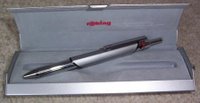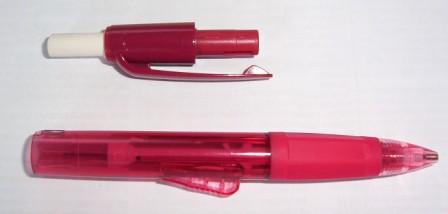Yes, well, this is a mechanical pencil blog so even though it’s seemingly always referred to as the Rotring Newton Trio Pen, I am going to call it pen / pencil. After all this review will be with a pencil bias, not pen.
The Rotring Newton is named after Sir Isaac Newton, the great 17th Century physicist, scientist and “thinker”. Personally I find the look of the Trio rather reflective of this idea. The round metal body has longitudinal lines along it and is shiny chrome plated, unlike the central “sleeve” section which is matt. Viewed side on, the hexagonal sleeve section looks as though it is a part of an equilateral triangle and the pocket clip attachment continues this triangular line. It all combines so the whole look of this pen/pencil is very scientific or mathematical, and I take my hat off to the stylists at Rotring, they have really come up with the goods on this one.
That hexagonal central section also stops the pen/pencil rolling around on your desk, and adds more weight giving a top heavy feel. The pocket clip is a good solid spring loaded item, no worries there. The grip is OK, about what you would expect from a plain metal finish barrel – it can get a little slippery after extended use.
My Trio has black and red ballpoints and a 0.5mm pencil. I believe other configurations are available. As a ballpoint, the refills write well, but they did seem to be the type that collects stuff on the ballpoint so you often get a small blob when you start writing again. It does seem to me that some ballpoints are more prone to this than others, but obviously the paper and other factors are also important. Being a multi-pen, the refills are only very small, probably only holding about 1/10th of a normal pen. Likewise the pencil cartridge only holds 1 or 2 spare leads, but that’s probably not a big deal. I imagine the pen refill size is more of an issue for your average user. To refill the pencil, or replace a pen refill, you have to unscrew the body from the sleeve section to access the cartridges. How do you select the pencil or red or black pen? Well back in 1666 when apocryphal apples were bouncing off Isaac’s head, he got to thinking and came up with the theory of gravity. So, it’s entirely appropriate that the Newton Trio has a gravity controlled selector system. Up at the top of the pen/pencil there are three “dots” (‘black’, ‘red’ and ‘0.5’) set at 90 degrees to each other. You hold the body horizontal with the appropriate dot on top and that’s the tip that will come out when you push the top cap down. Obviously a little weighted spindle orientates the refills inside the body. Very cool. No twisting a section around or anything like that. I am sure the great man himself would approve. If you want the pencil you just hold it so ‘0.5’ is on top and push that big top cap down. There is a little raised button that you push to retract the tip when you have finished writing or want to select a new tip. It is spring loaded retraction, and produces a very satisfying “K-chink” as the tip slams back home inside the body. When you push down on the top cap to extend the selected tip, it’s quite easy for the pens, but you have to push fairly hard to extend the pencil out. The pencil is a push top ratchet, and it’s the same when you use the top cap to activate the lead advance, you have to give it a bit of extra oomph.
How do you select the pencil or red or black pen? Well back in 1666 when apocryphal apples were bouncing off Isaac’s head, he got to thinking and came up with the theory of gravity. So, it’s entirely appropriate that the Newton Trio has a gravity controlled selector system. Up at the top of the pen/pencil there are three “dots” (‘black’, ‘red’ and ‘0.5’) set at 90 degrees to each other. You hold the body horizontal with the appropriate dot on top and that’s the tip that will come out when you push the top cap down. Obviously a little weighted spindle orientates the refills inside the body. Very cool. No twisting a section around or anything like that. I am sure the great man himself would approve. If you want the pencil you just hold it so ‘0.5’ is on top and push that big top cap down. There is a little raised button that you push to retract the tip when you have finished writing or want to select a new tip. It is spring loaded retraction, and produces a very satisfying “K-chink” as the tip slams back home inside the body. When you push down on the top cap to extend the selected tip, it’s quite easy for the pens, but you have to push fairly hard to extend the pencil out. The pencil is a push top ratchet, and it’s the same when you use the top cap to activate the lead advance, you have to give it a bit of extra oomph.
There is a small “better than nothing” eraser under the top cap, but it’s very difficult to get the top cap off when the pencil is in use because the cap is depressed into the body. You have to retract the pencil tip, and then take the top cap off. Pushing the top cap back on nearly always advances a tip out of the body so you need to be aware of what dots facing up at the time! The Newton Trio comes in a small metal presentation tin - adequate, but nothing fancy. Overall this is a great multi pen/pencil.
The Newton Trio comes in a small metal presentation tin - adequate, but nothing fancy. Overall this is a great multi pen/pencil.
- Best Points – The looks and selector system. Surely Sir Isaac would approve?
- Not So Good Points – The push top ratchet lead advance mechanism is not as sharp and precise feeling as a normal pencil.
- Price Range – Mid/high.
Dimensions – Length 129mm, diameter 9mm barrel, hex section 11mm across the flats. Balance point about 75mm up from the tip.
 Well finally of course we need the German / NZ connection for a good German Rotring instrument. Carl Sylvius Volkner (1819 – 1865) was a German Protestant missionary sent to New Zealand in 1849. During the period of the New Zealand Wars he effectively became a government informant against his Maori parish and certain heretical Christian sects. This culminated in his murder / execution by anti-government forces, and then of course subsequent government military actions to punish the offenders.
Well finally of course we need the German / NZ connection for a good German Rotring instrument. Carl Sylvius Volkner (1819 – 1865) was a German Protestant missionary sent to New Zealand in 1849. During the period of the New Zealand Wars he effectively became a government informant against his Maori parish and certain heretical Christian sects. This culminated in his murder / execution by anti-government forces, and then of course subsequent government military actions to punish the offenders.









 The Rotring Core mechanical pencil comes in several different decorations, mine is the 0.7mm Tecnor, which reminds me of a shark with that wave-tooth pattern on the body. The body is fully rubberised in black and blue, with metal tip, cap and pocket-clip. This style is obviously aiming for a modern electronic irreverent sort of look, presumably to appeal to a younger market segment - the writing instrument for those who wear “Rugged Shark” or “Rip Curl” apparel.
The Rotring Core mechanical pencil comes in several different decorations, mine is the 0.7mm Tecnor, which reminds me of a shark with that wave-tooth pattern on the body. The body is fully rubberised in black and blue, with metal tip, cap and pocket-clip. This style is obviously aiming for a modern electronic irreverent sort of look, presumably to appeal to a younger market segment - the writing instrument for those who wear “Rugged Shark” or “Rip Curl” apparel.






